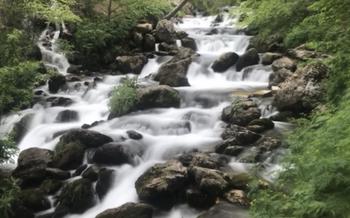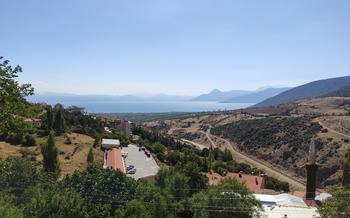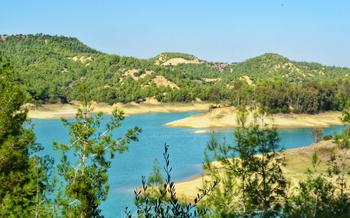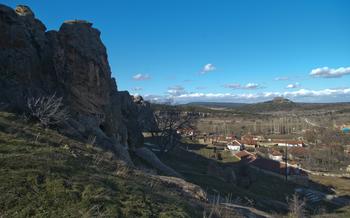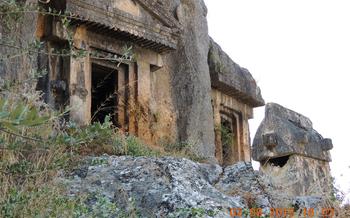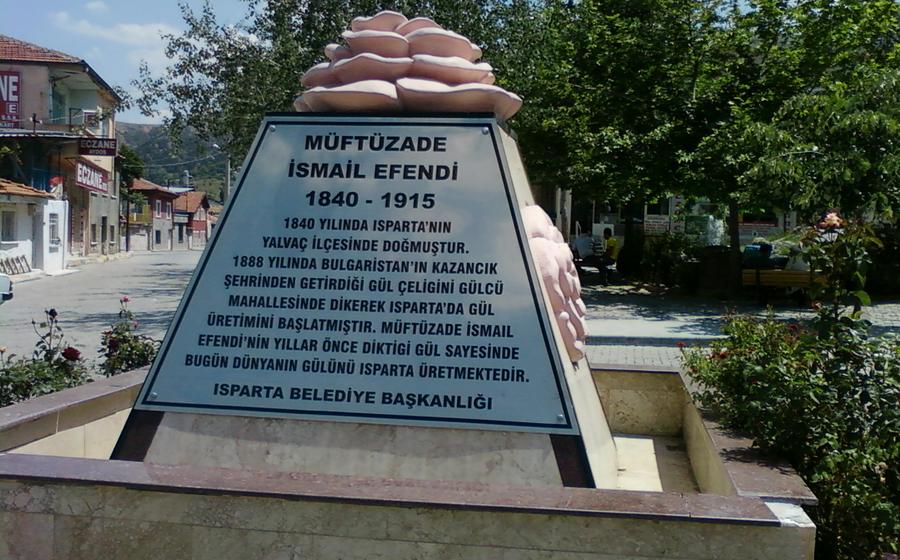
Karakuyu Monument Tomb
- Unveiling Karakuyu Monument Tomb: Embark on a Journey into History
- Location and Accessibility: Discovering the Enchanting Town of Isparta
- Delving into the Past: Exploring the History of the Monument
- Unearthing the Architectural Marvel: A Masterpiece of Stone
- Unveiling the Mysteries: The Enigma of the Karakuyu Monument
- A Glimpse into Ancient Rituals: Funerary Practices and Traditions
- A Place of Reverence: Legends and Folklore of the Tomb
- A Haven for Nature Enthusiasts: Surrounding Landscape and Serenity
- Combining History and Modernity: Isparta's Cultural Treasures
- A Culinary Journey: Savoring the Delights of Isparta Cuisine
- Shopping for Souvenirs: Unique Crafts and Local Treasures
- Accommodation Options: Finding Your Home Away from Home
- Insider Tip:
- Safety and Precautions: Ensuring a Safe and Enjoyable Visit
- Insider Tip: Enhancing Your Experience at the Karakuyu Monument
Unveiling Karakuyu Monument Tomb: Embark on a Journey into History
Standing as a testament to ancient civilizations, the Karakuyu Monument Tomb in Isparta, Turkey, invites travelers to unravel its intriguing history. Built in the 4th century BC, this remarkable monument is believed to be the final resting place of an important Lycian figure, possibly a ruler or a high-ranking official. Legends and myths surround the tomb, adding to its enigmatic charm. Its unique architectural features and exquisite stone carvings provide valuable insights into the artistic and cultural heritage of the region, making it a must-visit destination for history enthusiasts and culture seekers.
Location and Accessibility: Discovering the Enchanting Town of Isparta
Isparta, a captivating town in southwestern Turkey, is nestled amidst the picturesque landscapes of the Taurus Mountains. Its proximity to major cities like Antalya and Denizli makes it an easily accessible destination. Whether you choose to travel by road, rail, or air, Isparta welcomes visitors with open arms.
To reach Isparta by road, you can embark on a scenic drive along well-maintained highways. The town is well-connected by bus services from neighboring cities, offering a comfortable and affordable option for travelers. If you prefer the convenience of air travel, Isparta boasts a small airport with regular flights from Istanbul and other major hubs.
Once in Isparta, you will find the locals to be warm and welcoming. Respecting their customs and etiquette is essential for a harmonious travel experience. For instance, dressing modestly and greeting people with a friendly "Merhaba" (hello) are simple gestures that go a long way.
The best time to visit Isparta is during the shoulder seasons (spring and autumn) when the weather is pleasant and mild. Summer can be hot and dry, while winters bring chilly temperatures and occasional snowfall. However, each season offers its unique charm, whether it's the vibrant colors of spring, the warm embrace of summer, the crisp air of autumn, or the snowy wonderland of winter.
Delving into the Past: Exploring the History of the Monument
The Karakuyu Monument Tomb stands as a testament to the rich history and cultural heritage of Isparta. Its origins can be traced back to the ancient Phrygian civilization, who inhabited the region during the 8th century BC. The Phrygians were known for their advanced metalworking and sophisticated artistic traditions, which are evident in the intricate carvings and decorations adorning the tomb.
Archaeological excavations at the site have unearthed a wealth of artifacts and inscriptions, shedding light on the tomb's construction and purpose. These discoveries suggest that the tomb was likely built as a royal mausoleum, serving as the final resting place for a prominent Phrygian ruler or high-ranking official. The grandeur and opulence of the tomb reflect the power and prestige of the Phrygian elite.
Over the centuries, the Karakuyu Monument Tomb has witnessed the rise and fall of numerous civilizations, each leaving their mark on the region. The tomb's location at the crossroads of major trade routes made it a strategic and desirable location, attracting various empires and kingdoms. Hellenistic, Roman, and Byzantine influences can be seen in the architectural elements and decorative motifs incorporated into the tomb's design.
Despite the passage of time and the ravages of history, the Karakuyu Monument Tomb has remarkably withstood the test of time. Conservation efforts have been undertaken to preserve and restore the tomb's integrity, ensuring that it remains a symbol of Isparta's rich cultural heritage for generations to come.
Unearthing the Architectural Marvel: A Masterpiece of Stone
The Karakuyu Monument Tomb stands as a testament to the architectural prowess of its creators. Its distinctive style blends elements of ancient Anatolian and Hellenistic influences, resulting in a unique and captivating structure. Constructed using locally sourced limestone, the tomb's exterior is adorned with intricate carvings and bas-reliefs that depict scenes from mythology, nature, and everyday life. These intricate details offer a glimpse into the artistry and craftsmanship of the ancient civilization that built this remarkable monument.
The tomb's façade boasts a series of columns and pilasters that support a triangular pediment. The columns feature intricate carvings of acanthus leaves, while the pediment displays a relief depicting a scene of a chariot race, symbolizing the journey of the soul into the afterlife. The tomb's entrance is flanked by two large lions, representing strength and guardianship, and is topped by an ornate lintel featuring a rosette motif.
Inside the tomb, visitors can admire the barrel-vaulted ceiling, which is decorated with frescoes depicting various celestial bodies and constellations. The walls are adorned with niches and panels that once housed statues and offerings to the deceased. The tomb's interior is a testament to the importance and reverence with which the ancient civilization regarded their dead.
Comparisons can be drawn between the Karakuyu Monument Tomb and other notable monuments of the period, such as the Mausoleum at Halicarnassus and the Temple of Artemis at Ephesus. While each of these structures is unique in its own right, they share a commonality in their grand scale, intricate ornamentation, and symbolic significance. The Karakuyu Monument Tomb stands as an equally impressive example of ancient architectural achievement, offering a glimpse into the rich cultural heritage of the region.
Unveiling the Mysteries: The Enigma of the Karakuyu Monument
The Karakuyu Monument Tomb has remained an enigma, sparking numerous theories and speculations about its purpose and significance. One popular belief is that it was a royal mausoleum, possibly the resting place of a powerful ruler or a prominent figure from ancient times. Another theory suggests that it served as a temple or a place of worship, dedicated to an unknown deity or a sacred entity.
Some researchers believe that the tomb is linked to a lost civilization or an advanced society that inhabited the region in the distant past. The intricate carvings and decorations on the tomb's façade are often cited as evidence of a sophisticated culture with a rich artistic tradition.
Mythological interpretations also abound, with local legends suggesting that the tomb is guarded by spirits or deities who protect its secrets. Some stories speak of curses or magical powers associated with the monument, adding to its mystique and allure.
Despite the numerous theories and speculations, the true purpose and significance of the Karakuyu Monument Tomb remain shrouded in mystery. This enigmatic nature is part of its charm, inviting visitors to ponder its secrets and unravel its hidden stories. Preserving the enigmatic aura of the tomb is crucial to maintaining its allure and allowing future generations to explore and discover its mysteries.
A Glimpse into Ancient Rituals: Funerary Practices and Traditions
The Karakuyu Monument Tomb offers a unique glimpse into ancient funerary practices and traditions. The tomb's construction and design were influenced by the beliefs and customs of the ancient civilization that built it. Excavations and studies have revealed insights into the rituals and ceremonies associated with the tomb.
Ancient Beliefs and Customs:
The ancients believed in the afterlife, where the soul continued to exist after death. The tomb's location and orientation were carefully chosen to align with their beliefs about the journey to the afterlife. The tomb's entrance faces the rising sun, symbolizing the deceased's passage into a new realm.
Symbolism of the Tomb:
The tomb's architecture and decorations reflect the ancient culture's symbolism and beliefs. Motifs such as flowers, birds, and celestial bodies adorn the tomb, representing life, rebirth, and the connection between the earthly and spiritual realms.
Comparison with Other Civilizations:
Comparing the Karakuyu Monument Tomb with funerary practices of other civilizations provides valuable insights into cultural diversity and similarities. Similarities can be found in the use of burial chambers, grave goods, and rituals to honor the deceased.
Understanding these ancient funerary practices helps us appreciate the cultural and religious beliefs of the past. The Karakuyu Monument Tomb serves as a testament to the rich traditions and rituals that shaped ancient civilizations.
A Place of Reverence: Legends and Folklore of the Tomb
The Karakuyu Monument Tomb has become a place of reverence and mystery, attracting visitors with its enigmatic aura and captivating legends. Local folklore and tales have woven a rich tapestry around the tomb, adding to its allure. One enduring legend speaks of a beautiful princess who was tragically killed by a jealous rival. Her heartbroken father, unable to bear the loss, had the tomb constructed as a tribute to his beloved daughter. It is said that her spirit still lingers within the tomb, guarding its secrets.
Another tale tells of a powerful warrior who was buried in the tomb with his prized possessions, including a legendary sword. According to the legend, anyone who attempts to claim the sword will be met with the wrath of the warrior's spirit. These stories have been passed down through generations, becoming an integral part of the tomb's mystique and adding to its allure for travelers and locals alike.
A Haven for Nature Enthusiasts: Surrounding Landscape and Serenity
Beyond the historical significance of the Karakuyu Monument Tomb, Isparta offers a serene retreat for nature lovers. The surrounding countryside boasts breathtaking landscapes, inviting visitors to explore the region's natural wonders. Picturesque hiking trails meander through verdant forests, leading to panoramic viewpoints that offer stunning vistas of the countryside. Birdwatching enthusiasts can indulge in the region's rich avian diversity, spotting colorful species that flit among the trees. Nature photography enthusiasts will find ample opportunities to capture the beauty of the landscape, with the Karakuyu Monument Tomb serving as a majestic backdrop.
Visitors can pack a picnic lunch and find a secluded spot amidst the natural beauty to savor the tranquility of the surroundings. The fresh air, the gentle breeze rustling through the leaves, and the melodious chirping of birds create a symphony of nature that soothes the soul. Whether you're an avid hiker, a birdwatching enthusiast, or simply seeking a peaceful escape, the countryside surrounding the Karakuyu Monument Tomb offers a sanctuary for nature lovers to connect with the beauty of the natural world.
Remember to respect the local environment and wildlife during your explorations. Avoid littering, stay on designated trails, and observe wildlife from a distance without disturbing their natural behavior. Embrace the opportunity to immerse yourself in the serenity of nature and create lasting memories in this enchanting landscape.
Combining History and Modernity: Isparta's Cultural Treasures
Beyond the Karakuyu Monument Tomb, Isparta is a treasure trove of historical and cultural attractions. History buffs can delve into the past at the Isparta Museum, which houses a collection of artifacts from the region's rich history, including archaeological finds from the Karakuyu site.
The Isparta Castle, a 13th-century Byzantine fortress, offers a glimpse into the town's medieval heritage. Located on a hilltop overlooking the city, the castle boasts stunning panoramic views of the surrounding countryside.
For those seeking a taste of contemporary culture, Isparta offers a vibrant arts scene, with art galleries showcasing the works of local and international artists. The city also boasts several theaters and music venues, hosting performances ranging from traditional Turkish music to modern dance and theater productions.
A Culinary Journey: Savoring the Delights of Isparta Cuisine
Dive into the culinary delights of Isparta, where traditional flavors blend with modern gastronomy. Savor the aromatic scents of freshly baked pide, a traditional Turkish flatbread, or indulge in the richness of Isparta kebabs, grilled to perfection and served with tantalizing spices. Don't miss the Isparta güllacı, a delicate dessert made with rosewater and rice, a true testament to the region's love for roses.
Head to the bustling local markets, where you can witness the vibrant colors of fresh produce, aromatic spices, and traditional sweets. Engage with friendly vendors, learn about their culinary traditions, and pick up some unique ingredients to recreate Ispartan flavors back home.
Discover hidden culinary gems tucked away in the narrow streets of Isparta's old town. Unassuming eateries serve up authentic dishes passed down through generations, offering a glimpse into the heart of Turkish cuisine. Don't be afraid to venture off the beaten path and let your taste buds guide you to unforgettable gastronomic experiences.
When dining in Isparta, embrace local customs and etiquette. Show respect by removing your shoes before entering a traditional Turkish house or restaurant. Enjoy the leisurely pace of Turkish meals, savoring each course and engaging in lively conversations with your dining companions.
Food in Isparta is not just nourishment but a celebration of life and community. Join the locals as they gather around shared plates, sharing stories, laughter, and the warmth of Turkish hospitality. Embrace the culinary journey that awaits you in Isparta, where every bite tells a tale of tradition, culture, and the enduring spirit of this enchanting Turkish city.
Shopping for Souvenirs: Unique Crafts and Local Treasures
Immerse yourself in the vibrant culture of Isparta by exploring its bustling markets and bazaars. Discover an array of handmade crafts and souvenirs that showcase the region's rich heritage and artistry. From intricate carpets and textiles to exquisite pottery and jewelry, each piece tells a story and carries a piece of Isparta's soul. Support local artisans and keep traditional skills alive by purchasing authentic souvenirs.
Negotiating is an integral part of the shopping experience in Isparta, so don't be afraid to engage in friendly bargaining. Always approach vendors with respect and a smile, and be prepared to walk away if the price is too high. Remember, the goal is to find a fair price for both parties.
The Old Bazaar is a must-visit for souvenir hunters, with its labyrinthine streets lined with shops selling everything from spices to antiques. For a more modern shopping experience, head to the Isparta Mall, which offers a wide range of local and international brands.
No matter where you choose to shop, be sure to take your time and soak up the vibrant atmosphere. Converse with the locals, learn about their culture, and make memories that will last a lifetime.
Accommodation Options: Finding Your Home Away from Home
Isparta offers a range of accommodation options to suit every budget and preference. From modern hotels to traditional guesthouses, there is something for every traveler.
For those who prefer a luxurious stay, there are several upscale hotels located near the city center. These hotels offer amenities such as swimming pools, spas, and fitness centers, as well as easy access to restaurants, shops, and cultural attractions.
For those on a tighter budget, there are several affordable guesthouses and hostels available. These guesthouses often offer a more local experience, with shared rooms and kitchens. They are also a great way to meet other travelers and make new friends.
For those who want a truly unique experience, there are several charming homestays available in Isparta. These homestays offer a chance to live with a local family and experience Turkish culture firsthand.
No matter what your budget or preferences, you are sure to find the perfect accommodation in Isparta.
Insider Tip:
Consider staying in a traditional Ottoman house. These houses, which are typically made of wood and stone, offer a unique and authentic experience. They are often located in the historical center of the city, within walking distance of many of the city's attractions.
Safety and Precautions: Ensuring a Safe and Enjoyable Visit
When embarking on your journey to Isparta, your safety and well-being should be a top priority. Here are some essential tips to ensure a safe and enjoyable visit:
-
General Safety: Isparta is generally considered a safe city for travelers. However, as with any destination, it's important to exercise common sense and stay vigilant. Be aware of your surroundings, especially in crowded areas, and avoid walking alone at night.
-
Tourist Traps: While Isparta is not known for being a major tourist hub, it's still advisable to be cautious of potential scams. Be wary of individuals offering overly friendly services or unsolicited guidance. Always verify prices and services before engaging with anyone.
-
Local Customs: Respecting local customs and regulations is crucial for a harmonious travel experience. Dress modestly, especially when visiting religious sites. Avoid public displays of affection, as they may be frowned upon. Respect the local way of life and refrain from engaging in activities that could be considered offensive.
-
Emergency Contacts: Keep emergency contact numbers handy, such as the local police station and tourist information center. In case of any emergency, dial 112 for assistance.
Insider Tip: Enhancing Your Experience at the Karakuyu Monument
To fully appreciate the grandeur of the Karakuyu Monument, consider visiting during the golden hours of sunrise or sunset. The warm hues of the setting sun cast an ethereal glow on the tomb, creating a magical atmosphere. Moreover, the early morning or late afternoon light provides ideal conditions for photography, allowing you to capture the monument's intricate details and the surrounding landscape in all its glory.
Enhance your visit by hiring a local guide who can provide valuable insights into the history, legends, and symbolism associated with the tomb. Local guides often have a wealth of knowledge and can share fascinating stories that bring the monument to life. They can also point out hidden details and explain the cultural significance of the site, making your experience more enriching and memorable.
Combine your visit to the Karakuyu Monument with a tour of other nearby attractions in Isparta. The city is home to several other historical sites, museums, and natural wonders that are worth exploring. Consider visiting the Isparta Archaeological Museum to learn more about the region's rich history and culture, or embark on a scenic hike in the surrounding mountains for breathtaking views and a chance to connect with nature.
For photography enthusiasts, the Karakuyu Monument offers a wealth of opportunities to capture stunning images. Experiment with different angles and perspectives to showcase the monument's unique features and the surrounding landscape. Use a tripod to ensure sharp and steady shots, and consider using a wide-angle lens to capture the monument's grandeur in its entirety.

